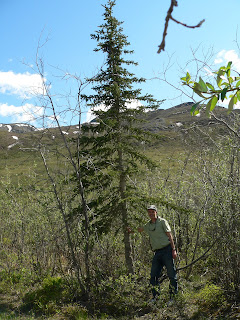Start of the highway.

Bridge over the Yukon River, mile 56

Just after crossing the Yukon River there were two Western Wood-pewees performing their dawn song at 11pm (we were after all in the land of the midnight sun). It was a little surprising to find this species so far north.

A little further along I recorded this sound which until recently remained unidentified. I posted it on the Yahoo nature recording group and received a reply that is probably a Canadian Lynx!
The boreal forest rang with the songs and calls of Varied, Swainson's and Gray-cheeked Thrushes.
Varied Thrush
Varied Thrush Hermit Thrush-like jup and rattle calls

Swainson's Thrush.
This Swainson's Thrush sang an odd song variant
"whip" and "wherr" calls.

Gray-cheeked Thrushes became more abundant further north as the trees became smaller
"peeuu" calls
Finger Rock at mile 98.

Open areas had singing Fox, White-crowned and American Tree Sparrows.
This Fox Sparrow was singing beautifully next to a brook.
American Tree Sparrow
Crossing the Arctic Circle at mile 115, latitude 66 degrees 33 minutes N.

Orange-crowned , Yellow and Wilson's Warbler were common.
Orange-crowned Warbler
Wilson's Warbler
We scanned areas of burned forest for Three-toed Woodpecker. Most of the burned trees were too thin to host breeding woodpeckers. Finally we heard one drumming in an area where the trees were larger. A tip for finding this species is to look for burned trees that have had pieces of bark peeled off by the woodpeckers. Here's a calling bird rapping at loose bark(and many mosquitoes).
The pipeline was often visible alongside the road.

We stopped beside a pond where a Lesser Yellowlegs called
A Long-tailed Duck was on the pond
and ran into several groups of White-winged Crossbill
jejeje call
trill
In an open area, we found a Northern Hawk Owl calling from a dead tree. (On the way back we found another feeding young in a hole near the top of a spruce).
The chapel at Wiseman, mile 189.

At mile 235 was the "Farthest North Spruce" which had been killed. Fortunately, the true farthest north spruce is a few yards further up the road.


Next we crossed the snow-capped Brooks range via the Atigun pass mile 244:


Dall sheep at the pass.

Beyond the Atigun pass Lapland Longspurs filled the air with their songs and calls
rattle
Typical Lapland Longspur habitat.

At a brook we found a Northern Shrike that was bringing food to a nest full of well-grown chicks.
Common Raven

One of the highlights of the trip was finding a singing Smith's Longspur north of the mountains about mile 300. The Sagavanirktok river is in the background
rattle
Yellow Wagtails flitted above us. On this recording, you can hear the wind. It was quite breezy most of the trip.
Caribou were frequently seen on the tundra, and we saw a number of moose driving through the boreal forest. We struck out on bear, wolf and musk ox.

South of Deadhorse, Franklin Bluffs can be seen to the east, a fascinating series of rock formations.

Approaching Deadhorse there were two pairs of Pacific Loon calling on a lake beside the road.
yodel
caaw
A pond in Deadhorse had a Spectacled Eider.

The Arctic Ocean was very inviting.

Red-necked Phalaropes were abundant around Deadhorse.

Here's their call
Leaving Deadhorse, we soon came across a Rock Ptarmigan beside the road. It had a strange croaking call.
Male Willow Ptarmigans were distinguishable from the pictured Rock Ptarmigan by their rufous heads and necks.

Bar-tailed Godwits, summer visitors from Australasia,one with an orange leg tag, were displaying over the tundra
Redpolls, Common and Hoary, were common along the road, especially in more open habitat. Hoary were found north of the Brooks range.
Redpoll in flight
Hoary Redpoll singing
Returning home through the boreal forest we noticed a couple of dark specks on the road. Stopping the vehicle, we got out and discovered that they were Wilson's Snipe chicks. We picked up and placed the peeping chicks safely off the road.

Calls of the snipe chicks:
This is the distress call of the parent
This Wilson's Snipe was calling from the top of a spruce
Crossing back over the Yukon River bridge.

No comments:
Post a Comment